Toyota Masters The Art Of The Conjunctive
The hybrid lexicon is a language built on a foundation of disjunction. Buyers may have phenomenal fuel economy or space for kids and cargo. You can embarrass your neighbors at the fuel pump or have a satisfying driving experience. In fact, opting for a battery pack is so fraught with compromise that it's almost as if hybrid manufacturers have completely deleted the conjunctive 'and' from their diction. Even so, that fact hasn't stopped buyers from seeking out electrified vehicles in increasing numbers.
Toyota has sold over one million Prius models in the United States since the vehicle first debuted a decade ago. That number blossoms to two million if global sales are accounted for, and the model's popularity has helped usher in a bloom of hybrid products from over 16 manufacturers. The technology may not be the perfect solution to our fuel economy concerns, but the Prius has taken off in ways that would have been difficult to imagine when the first gangly example whirred off the line.
Now Toyota is set to grow its Prius lineup with three new models. In fact, Bob Carter, Toyota division group vice president and general manager, says that the Japanese automaker fully expects the Prius family to become its best-selling product line in the near future – beating out internal combustion titans like the Camry and Corolla in the process. As a result, the company is planning to unleash of a barrage of products that include a model based on the Prius C Concept, a plug-in version of the hybrid and the taller, boxier Prius V. The thought is that a few simple variations on the company's successful battery-powered recipe will offer buyers solutions that the conventional Prius simply couldn't match. The only question is whether or not the will respond to what is effectively a few clever re-body jobs. If the Prius V is any indication, the answer is a resounding yes.
Thanks to years of steady sales, legions of faithful buyers and an overwhelming popularity with the celebrity set, the Prius has established itself as an icon of automotive design. Unsurprisingly, Toyota says that the Prius has the highest brand awareness of any hybrid on the road right now, and when it came time to design the Prius V, the company's artists wanted to ensure that the newcomer was instantly recognizable as a member of the Prius dynasty. For aerodynamic reasons, that meant maintaining the wedge-like shape of the liftback, though with a slightly taller roof for greater functionality.
Up front, the vehicle wears both stylized head lamps and a rounded front fascia that's remarkably similar to the 2011 Prius, though it's worth noting that the front fenders and hood are completely new sheetmetal. In fact, the headlight housings themselves have been slightly altered to incorporate a new ridge that reduces wind turbulence around the side view mirrors. Toyota says that the small change has a huge impact on interior noise.
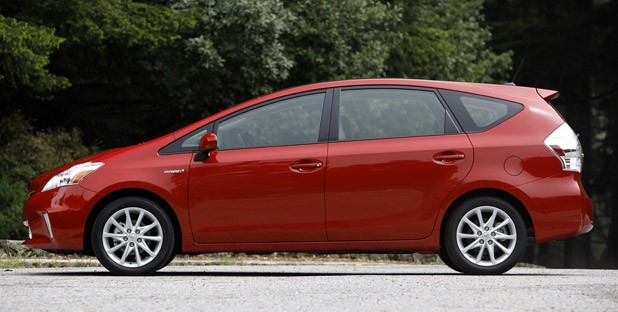
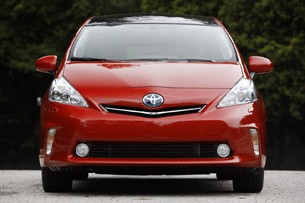
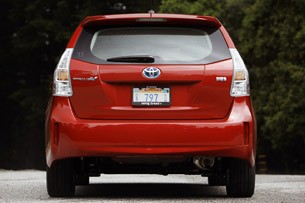
From the side, it's nearly impossible to escape the wagon-like presence of the Prius V. With its long roof, similarly lengthy rear doors and an extended cargo area, the vehicle ditches the awkward hatchback aesthetics of the current Prius for a twang of normalcy. We couldn't help but grow a little fond of the vehicle's shape after a day behind the wheel. It's almost as if Toyota has flanked us by using our love for wagons to lure us into the hybrid craze.
We spent time in the top-o-the-line Prius V Five trim level, complete with larger 17-inch wheels. The multi-spoke rollers aren't the most stylish stock on the planet, but from where we sit, they're far more attractive than the chunky designs of the Honda Insight and Civic hybrids.
From the rear, the Prius V offers up a fairly sizable hatch that terminates in a unique rear spoiler. As you might have guessed, the piece actually serves to benefit the Prius V aerodynamically. Speaking of slipping through the air, Toyota's designers and engineers have worked to decrease the vehicle's coefficient of drag as much as possible to increase fuel efficiency. As such, touches like protrusions from the front and rear bumper, specially-designed side skirts and extensive underbody cladding help the Prius V return its .29 coefficient of drag.
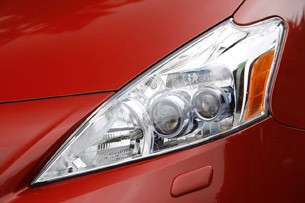
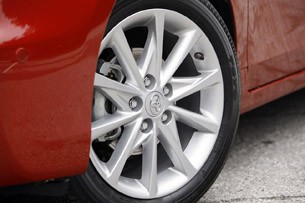
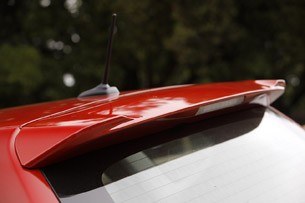
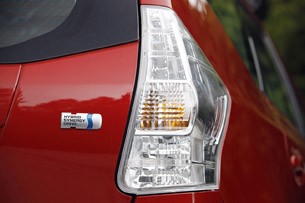
Toyota has also worked to keep weight as slim as possible on the Prius V, and those efforts have translated into unique material selections indoors. The Prius V will be available in a trio of trims labeled Two, Three and Five, with the top two tiers receiving a new faux leather surface that's lighter than real cowhide. In addition, a dual-pane resin panoramic roof is available on Five-trimmed models. The material is 40 percent lighter than standard laminated glass and also helps reduce solar gain to keep the interior cool on sunny days. Finally, Toyota has partnered with JBL to create a sound system that not only weighs 37 percent less than the old gear, but also sucks down 80 percent less power, too.
Even so, the Prius V weighs in at 232 pounds more than its standard sibling, though the penalty is worth it when it comes to usable interior room. Toyota built the hybrid wagon with a set of manually-controlled multi-function back seats that can slide fore and aft, recline and fold semi-flat for a heap of versatility. As a result, there's up to 35.9 inches of legroom out back, which is 1.4 inches more than the Honda CR-V can offer. With the thrones up, there's a full 34.3 cubic-feet of cargo room, and that number swells to 67.3 cubes with the back seats folded. As Toyota points out, that's more room than crossovers like the Chevrolet Equinox, Honda Element, Ford Escape or the Nissan Rogue can offer.
With large rear doors and a high hip point, back passengers are treated to a vehicle that's a cinch to slip into. We were perfectly content to spend a little time being chauffeured around the greater San Francisco area in the hybrid. But while the back seats are the big news for the Prius V, the front buckets offer a few surprises as well. The designers at Toyota have implemented concave door panels to provide more knee room and to help suggest a more open, airy cabin. Further, the Prius V wears upper dash panels that are so soft they're very nearly plush, and the same material is found at elbow level on the front door panels as well. While there's plenty of easily scratched, easily sullied hard plastic around, the Prius V delivers an interior that's suitably attractive and comfortable given the segment.
The Prius V also bows with Entune – a new smartphone-based application system. Check out our Short Cut video below to see what it's all about.
Unfortunately, the driver is met with a version of the same confounding center-up gauge cluster found in the base Prius. We have a general aversion to center-mounted gauges for a variety of reasons, the most pressing of which is that they require the driver to look down and away from the road. Passengers don't need to know how fast the vehicle is traveling; the driver does.
The engineers behind the Prius V essentially stretched the Prius floorpan to give the new model an extra three inches of wheelbase and six inches of overall length. Combined with its taller roof, additional glass and large rear hatch, the newcomer weighs in at 3,274 pounds. Toyota has opted to skip throwing extra horsepower at all that heft. Instead, the company's engineers simply changed the vehicle's axle ratio from 3.268:1 to 3.704:1. As a result, the Prius V feels just as adequate on the road as the third-generation Prius.
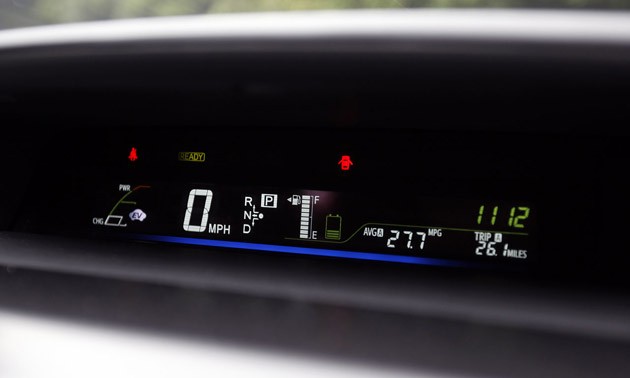
Under the hood, the same 2ZR-FXE 1.8-liter Atkinson-cycle four-cylinder engine found in the base Prius supplies power in conjunction with a pair of liquid-cooled motor generators. Engineers designed the transaxle case in the Prius V with integrated water jackets for the first time to keep the motors at a steady temperature, thereby increasing longevity and performance at the same time. Combined output sits at 134 horsepower at 5,200 rpm and 105 pound-feet of torque at 4,000 rpm. Toyota has also redesigned the vehicle's exhaust heat recirculation system to decrease the drivetrain's warm-up period, and as a result, the Prius V can reach optimum operating temperature up to a minute sooner than vehicles equipped with the old system.
Automakers are flocking to lithium-ion batteries in increasing numbers at the moment, but Toyota says it saw no need to pursue the added cost of the technology for the Prius V. Instead, the hybrid wagon uses a modified version of the same nickel-metal hydride battery pack found in the third-gen Prius. Total output has been boosted slightly to 650 volts, and the more compact battery configuration keeps from impeding interior room. Additionally, the battery pack's cooling duct now draws ambient air from a hidden location under the second-row seats.
All told, this tech is good for an Environmental Protection Agency-rated 44 mpg city and 40 mpg highway. That works out to around 42 mpg combined, though we saw 38.6 mpg in aggressive mixed driving. Given that the average fuel economy was ticking up even as we whirred into the parking lot, we wouldn't be surprised to see the Prius V hit or exceed its EPA figures.
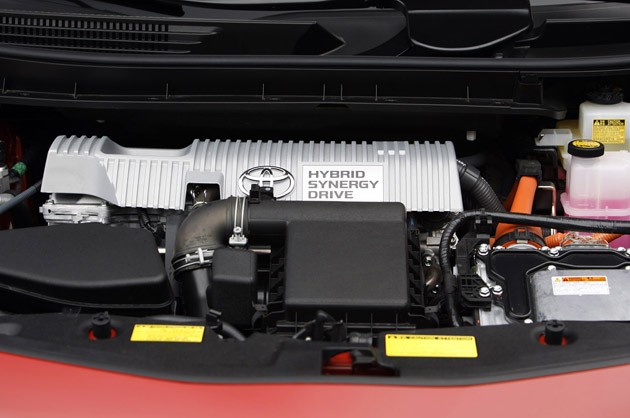
We fully expected to be met with a more lethargic, turgid version of the Prius when it came time to take the wheel. After all, shoving a taller roofline and over 200 pounds into the Japanese hybrid was bound to have ill effects, but judging by our time with the vehicle, that simply isn't the case. The new gear ratio means that acceleration is perfectly acceptable for matching wits with traffic either in town or on the highway with 0-60 mph sprints taking an estimated 10.4 seconds. A total of four drive modes are accessible via buttons mounted on the center console, including EV, Eco, Power and Normal models. We found no lack of power in Normal configuration, even when it came to tackling the formidable hills near California's Half Moon Bay.
Fat-finger the Eco mode, however, and you're rewarded with an altogether more infuriating driving experience. The ECU hacks away at power like Indiana Jones with a well-oiled machete. Ironically, if you have a penchant for keeping up with the vehicles around you, you'll need to bury the accelerator, thereby activating Power mode and defeating the purpose of limping along in Eco to begin with. Do yourself a favor and leave the vehicle in Normal mode.
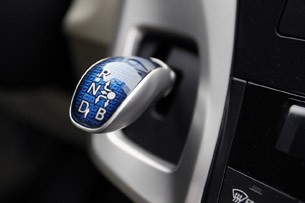
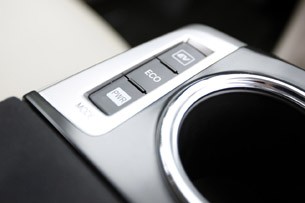
As with the rest of the Prius clan, the electronic power steering is lighter and less communicative than we'd like and the vehicle's regenerative brakes make for grabby stops. Still, the average Prius V buyer could probably care less about turn-in feel. Even so, with a MacPherson strut design up front and a torsion-beam rear, the tall wagon isn't a disappointing drive. In fact, we could entirely see ourselves living with this vehicle on a daily basis, especially if we had a brood to lug around at the same time. Despite its curb weight and low power figures, the Prius V feels fairly light on its feet. Body roll is apparent but unobtrusive and brake dive is kept in check as well.
Hybrids aren't typically happiest on the highway, but Toyota has taken steps to ensure that the Prius V is more livable over long distances. The new model is the first to incorporate Pitch and Bounce Control, which can sense the oscillating frequency of road surfaces and minutely induce and withdraw torque from the electric motor to counteract a vehicle's wave-like motion. The result is a very stable-feeling drive, especially over aged sections of concrete interstate and expansion joints.
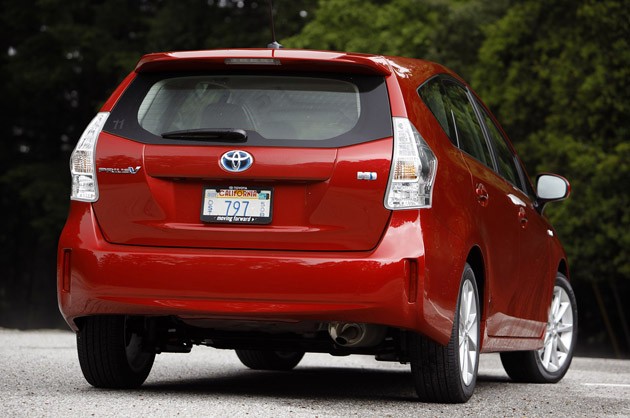
Toyota won't release final pricing information on the Prius V until closer to the model's fall launch date. As a result, it's difficult to give this wagon a confident endorsement. The company says that its newest hybrid is positioned to draw buyers who are currently looking toward small SUVs, crossovers and wagons, and they're dead right. The Prius V has all of the functionality of those vehicles with the fuel economy and panache that only the Prius name can offer.
If we were going to lay down a yet-to-be-determined chunk of change for a Prius, the V would certainly be the model to take home. Its small fuel economy sacrifices are more than made up for by increased versatility and backseat comfort. We even think the taller roof line makes the model more becoming. For the first time, the Prius name stands for fuel economy and functionality.
2012 Toyota Prius V - Click above for high-res image gallery
The hybrid lexicon is a language built on a foundation of disjunction. Buyers may have phenomenal fuel economy or space for kids and cargo. You can embarrass your neighbors at the fuel pump or have a satisfying driving experience. In fact, opting for a battery pack is so fraught with compromise that it's almost as if hybrid manufacturers have completely deleted the conjunctive 'and' from their diction. Even so, that fact hasn't stopped buyers from seeking out electrified vehicles in increasing numbers.
Toyota has sold over one million Prius models in the United States since the vehicle first debuted a decade ago. That number blossoms to two million if global sales are accounted for, and the model's popularity has helped usher in a bloom of hybrid products from over 16 manufacturers. The technology may not be the perfect solution to our fuel economy concerns, but the Prius has taken off in ways that would have been difficult to imagine when the first gangly example whirred off the line.
Now Toyota is set to grow its Prius lineup with three new models. In fact, Bob Carter, Toyota division group vice president and general manager, says that the Japanese automaker fully expects the Prius family to become its best-selling product line in the near future – beating out internal combustion titans like the Camry and Corolla in the process. As a result, the company is planning to unleash of a barrage of products that include a model based on the Prius C Concept, a plug-in version of the hybrid and the taller, boxier Prius V. The thought is that a few simple variations on the company's successful battery-powered recipe will offer buyers solutions that the conventional Prius simply couldn't match. The only question is whether or not the will respond to what is effectively a few clever re-body jobs. If the Prius V is any indication, the answer is a resounding yes.
Thanks to years of steady sales, legions of faithful buyers and an overwhelming popularity with the celebrity set, the Prius has established itself as an icon of automotive design. Unsurprisingly, Toyota says that the Prius has the highest brand awareness of any hybrid on the road right now, and when it came time to design the Prius V, the company's artists wanted to ensure that the newcomer was instantly recognizable as a member of the Prius dynasty. For aerodynamic reasons, that meant maintaining the wedge-like shape of the liftback, though with a slightly taller roof for greater functionality.
Up front, the vehicle wears both stylized head lamps and a rounded front fascia that's remarkably similar to the 2011 Prius, though it's worth noting that the front fenders and hood are completely new sheetmetal. In fact, the headlight housings themselves have been slightly altered to incorporate a new ridge that reduces wind turbulence around the side view mirrors. Toyota says that the small change has a huge impact on interior noise.



From the side, it's nearly impossible to escape the wagon-like presence of the Prius V. With its long roof, similarly lengthy rear doors and an extended cargo area, the vehicle ditches the awkward hatchback aesthetics of the current Prius for a twang of normalcy. We couldn't help but grow a little fond of the vehicle's shape after a day behind the wheel. It's almost as if Toyota has flanked us by using our love for wagons to lure us into the hybrid craze.
We spent time in the top-o-the-line Prius V Five trim level, complete with larger 17-inch wheels. The multi-spoke rollers aren't the most stylish stock on the planet, but from where we sit, they're far more attractive than the chunky designs of the Honda Insight and Civic hybrids.
From the rear, the Prius V offers up a fairly sizable hatch that terminates in a unique rear spoiler. As you might have guessed, the piece actually serves to benefit the Prius V aerodynamically. Speaking of slipping through the air, Toyota's designers and engineers have worked to decrease the vehicle's coefficient of drag as much as possible to increase fuel efficiency. As such, touches like protrusions from the front and rear bumper, specially-designed side skirts and extensive underbody cladding help the Prius V return its .29 coefficient of drag.




Toyota has also worked to keep weight as slim as possible on the Prius V, and those efforts have translated into unique material selections indoors. The Prius V will be available in a trio of trims labeled Two, Three and Five, with the top two tiers receiving a new faux leather surface that's lighter than real cowhide. In addition, a dual-pane resin panoramic roof is available on Five-trimmed models. The material is 40 percent lighter than standard laminated glass and also helps reduce solar gain to keep the interior cool on sunny days. Finally, Toyota has partnered with JBL to create a sound system that not only weighs 37 percent less than the old gear, but also sucks down 80 percent less power, too.
Even so, the Prius V weighs in at 232 pounds more than its standard sibling, though the penalty is worth it when it comes to usable interior room. Toyota built the hybrid wagon with a set of manually-controlled multi-function back seats that can slide fore and aft, recline and fold semi-flat for a heap of versatility. As a result, there's up to 35.9 inches of legroom out back, which is 1.4 inches more than the Honda CR-V can offer. With the thrones up, there's a full 34.3 cubic-feet of cargo room, and that number swells to 67.3 cubes with the back seats folded. As Toyota points out, that's more room than crossovers like the Chevrolet Equinox, Honda Element, Ford Escape or the Nissan Rogue can offer.
With large rear doors and a high hip point, back passengers are treated to a vehicle that's a cinch to slip into. We were perfectly content to spend a little time being chauffeured around the greater San Francisco area in the hybrid. But while the back seats are the big news for the Prius V, the front buckets offer a few surprises as well. The designers at Toyota have implemented concave door panels to provide more knee room and to help suggest a more open, airy cabin. Further, the Prius V wears upper dash panels that are so soft they're very nearly plush, and the same material is found at elbow level on the front door panels as well. While there's plenty of easily scratched, easily sullied hard plastic around, the Prius V delivers an interior that's suitably attractive and comfortable given the segment.
The Prius V also bows with Entune – a new smartphone-based application system. Check out our Short Cut video below to see what it's all about.
The video meant to be presented here is no longer available. Sorry for the inconvenience.
Unfortunately, the driver is met with a version of the same confounding center-up gauge cluster found in the base Prius. We have a general aversion to center-mounted gauges for a variety of reasons, the most pressing of which is that they require the driver to look down and away from the road. Passengers don't need to know how fast the vehicle is traveling; the driver does.
The engineers behind the Prius V essentially stretched the Prius floorpan to give the new model an extra three inches of wheelbase and six inches of overall length. Combined with its taller roof, additional glass and large rear hatch, the newcomer weighs in at 3,274 pounds. Toyota has opted to skip throwing extra horsepower at all that heft. Instead, the company's engineers simply changed the vehicle's axle ratio from 3.268:1 to 3.704:1. As a result, the Prius V feels just as adequate on the road as the third-generation Prius.

Under the hood, the same 2ZR-FXE 1.8-liter Atkinson-cycle four-cylinder engine found in the base Prius supplies power in conjunction with a pair of liquid-cooled motor generators. Engineers designed the transaxle case in the Prius V with integrated water jackets for the first time to keep the motors at a steady temperature, thereby increasing longevity and performance at the same time. Combined output sits at 134 horsepower at 5,200 rpm and 105 pound-feet of torque at 4,000 rpm. Toyota has also redesigned the vehicle's exhaust heat recirculation system to decrease the drivetrain's warm-up period, and as a result, the Prius V can reach optimum operating temperature up to a minute sooner than vehicles equipped with the old system.
Automakers are flocking to lithium-ion batteries in increasing numbers at the moment, but Toyota says it saw no need to pursue the added cost of the technology for the Prius V. Instead, the hybrid wagon uses a modified version of the same nickel-metal hydride battery pack found in the third-gen Prius. Total output has been boosted slightly to 650 volts, and the more compact battery configuration keeps from impeding interior room. Additionally, the battery pack's cooling duct now draws ambient air from a hidden location under the second-row seats.
All told, this tech is good for an Environmental Protection Agency-rated 44 mpg city and 40 mpg highway. That works out to around 42 mpg combined, though we saw 38.6 mpg in aggressive mixed driving. Given that the average fuel economy was ticking up even as we whirred into the parking lot, we wouldn't be surprised to see the Prius V hit or exceed its EPA figures.

We fully expected to be met with a more lethargic, turgid version of the Prius when it came time to take the wheel. After all, shoving a taller roofline and over 200 pounds into the Japanese hybrid was bound to have ill effects, but judging by our time with the vehicle, that simply isn't the case. The new gear ratio means that acceleration is perfectly acceptable for matching wits with traffic either in town or on the highway with 0-60 mph sprints taking an estimated 10.4 seconds. A total of four drive modes are accessible via buttons mounted on the center console, including EV, Eco, Power and Normal models. We found no lack of power in Normal configuration, even when it came to tackling the formidable hills near California's Half Moon Bay.
Fat-finger the Eco mode, however, and you're rewarded with an altogether more infuriating driving experience. The ECU hacks away at power like Indiana Jones with a well-oiled machete. Ironically, if you have a penchant for keeping up with the vehicles around you, you'll need to bury the accelerator, thereby activating Power mode and defeating the purpose of limping along in Eco to begin with. Do yourself a favor and leave the vehicle in Normal mode.


As with the rest of the Prius clan, the electronic power steering is lighter and less communicative than we'd like and the vehicle's regenerative brakes make for grabby stops. Still, the average Prius V buyer could probably care less about turn-in feel. Even so, with a MacPherson strut design up front and a torsion-beam rear, the tall wagon isn't a disappointing drive. In fact, we could entirely see ourselves living with this vehicle on a daily basis, especially if we had a brood to lug around at the same time. Despite its curb weight and low power figures, the Prius V feels fairly light on its feet. Body roll is apparent but unobtrusive and brake dive is kept in check as well.
Hybrids aren't typically happiest on the highway, but Toyota has taken steps to ensure that the Prius V is more livable over long distances. The new model is the first to incorporate Pitch and Bounce Control, which can sense the oscillating frequency of road surfaces and minutely induce and withdraw torque from the electric motor to counteract a vehicle's wave-like motion. The result is a very stable-feeling drive, especially over aged sections of concrete interstate and expansion joints.

Toyota won't release final pricing information on the Prius V until closer to the model's fall launch date. As a result, it's difficult to give this wagon a confident endorsement. The company says that its newest hybrid is positioned to draw buyers who are currently looking toward small SUVs, crossovers and wagons, and they're dead right. The Prius V has all of the functionality of those vehicles with the fuel economy and panache that only the Prius name can offer.
If we were going to lay down a yet-to-be-determined chunk of change for a Prius, the V would certainly be the model to take home. Its small fuel economy sacrifices are more than made up for by increased versatility and backseat comfort. We even think the taller roof line makes the model more becoming. For the first time, the Prius name stands for fuel economy and functionality.
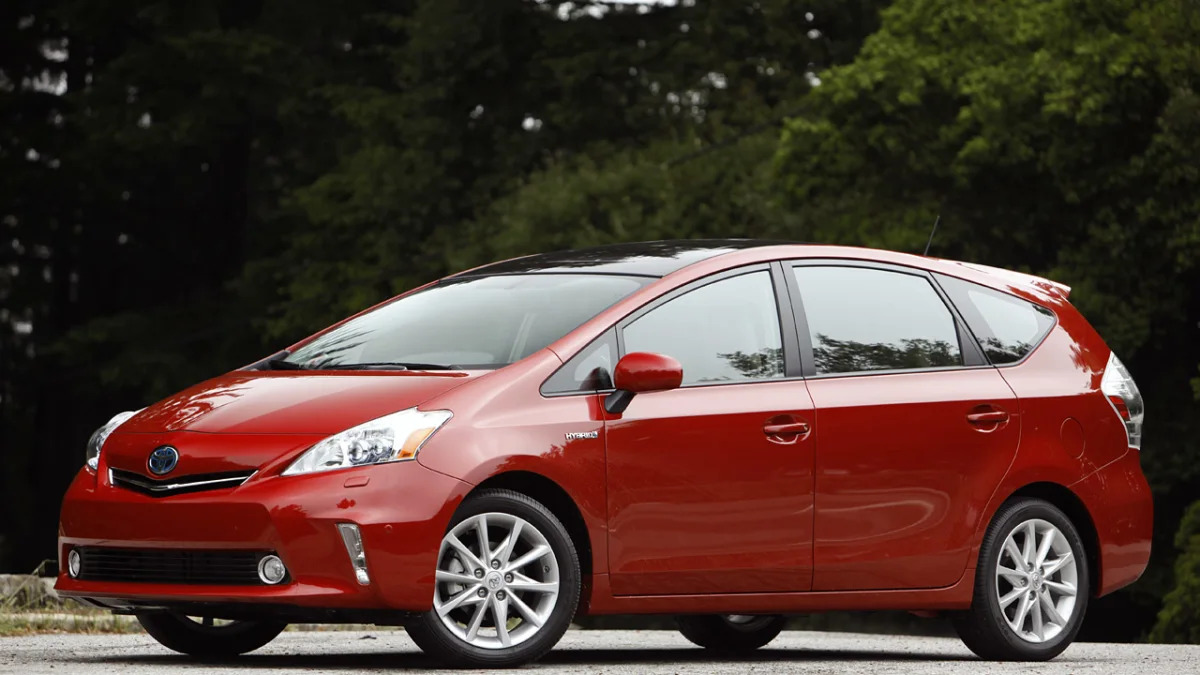
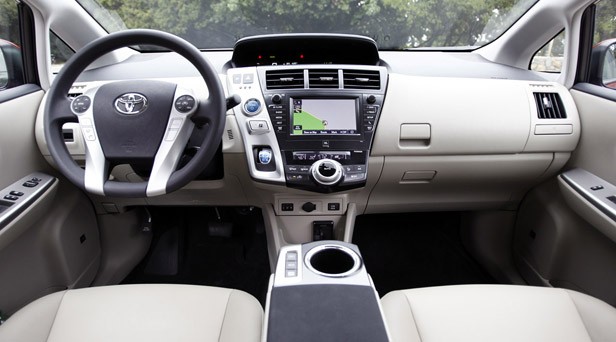
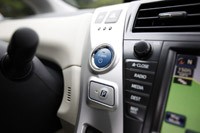
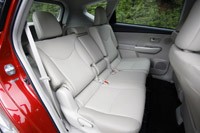
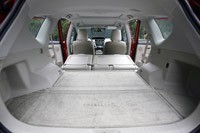









Sign in to post
Please sign in to leave a comment.
Continue